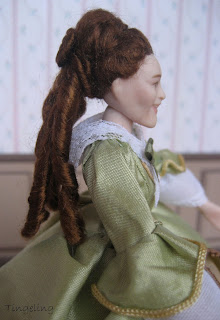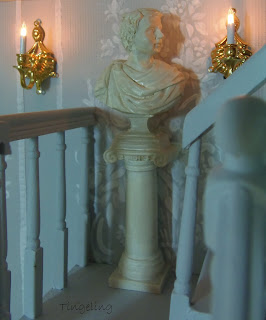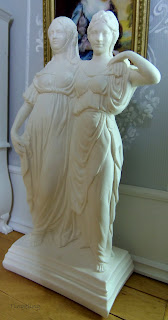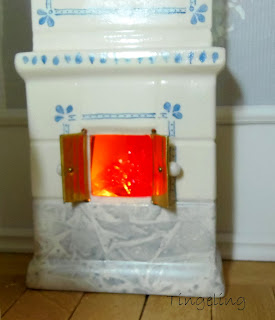1 viikko sitten
perjantai 17. elokuuta 2012
Halli, the hall
Eteishalli tuli vihdoin valmiiksi. Se on yhdistetty taidekokoelma veistoksia, grafiikkaa, keramiikkaa ja öljymaalauksia. Lisäksi siellä voi nauttia alkupalat ja juomat ennen siirtymistä ruokasaliin. Tilaa on myös viihtyisälle kahvinurkkauselle, jossa voi nauttia rauhassa kahvia sermien takana.
The hall is finally completed. It comprises an art collection of sculpture, graphics, china and oil paintings. In addition, there is possibility to enjoy entrees and drinks with art before going to the dining room upstairs. There is also a corner for a quiet coffee or tea time behind the screens.
Veistoskokoelma on Kustaa III:n vuonna 1794 avautuneen Tukholman antiikkimuseon inspiroima. Kustaan museo sisälsi 200 Italian grand tour matkaltaan hankkimaa veistosta Ruotsin kansan sivistämiseksi. Johan puolestaan sivistää Urskogsbyn kyläyhteisöä. Kokoelma koostuu mm. kreikkalaiseen mytologiaan kuuluvista hahmoista. Pienoispatsaat on hankittu matkamuistoina Kreikasta. Kaksoispatsas ostettu Tegelin lentokentältä Berliinistä.
The collection on sculptures is inspired by the antique museum of Gustav III opened in 1794 in Stockholms castle to where the king aquired 200 sculptures from his grand tour to Italia. The intention was to educate the people of Sweden. Johan in his turn educates the population of the Urskogsby village. The collection includes figures of the Greek mythology. The miniature sculptures have been bought as souvernirs from Greece. The twin sculpture is bought from Tegel airport in Berlin.
Posliinivaasikokoelman ylöspanoa on inspiroinut 1700-luvun Rundalen palatsi Latviassa.
The collection of china and its placement is ispired by china cabinet of 1700's Rundale palace in Latvia.
Huoneen muita yksityiskohtia: alkupalapöytä, nukkekotikaappi ja kaakeliuuni.
Other details of the room: table of entrees, dollhouse cabinet and a tiled fireplace.
Lapset kahvinurkkauksessa. The childen having a coffee by themselves while the bigger coffee table in the drawing room is reserved for the adults.
1700-luvulla tuli muotiin Englannista pohjolaan ns. printtihuone, jossa grafiikkaa liimattiin seinälle tapetin tapaan. Seinä oli värillinen ja grafiikka mustavalkoista. Muoti oli peräisin Italiasta, jossa jo 1500-luvulta lähtien työhuoneiden ylimmät seinät koristeltiin grafiikkavedoksin. Frjärilsgårdin kartanossa grafiikka on kiinnitetty sermeille. Keltainen oli tyypillinen väri printtihuoneen seinille.
In 18th century the so called Print Rooms became fashionable. The trend came from England to where it came from Italy where studios (working rooms) had been decorated by graphics since 16th century. The graphics were just pasted on the painted wall. In Fjärilsgårds manor the prints are pasted on the screens. Yellow was a typical colour for walls of the print rooms.
sunnuntai 15. tammikuuta 2012
Koruja, jewelry
sunnuntai 8. tammikuuta 2012
Lastenhuone, nursery

Maalattuani kehdon sain vihdoin lastenhuoneen valmiiksi. 1700-luvun lastenhuone koostui yleensä kahdesta osasta, päivähuoneesta, jossa keskityttiin opetukseen ja yöhuoneesta, jossa nukuttiin. Kartanossani päivähuonetta vastaa luokkahuone ja yöhuonetta lastenhuone, jossa saa vähän leikkiäkin.
After painting a cradle I finally completed the nursery. The nursery of the 18th century consisted often of day nursery for education and play and a night nursery for sleeping. In the manor the schoolroom substitutes the day nursery and the nursery corresponds a night room with a possibility for playing as well.


1700-luvun pohjoismainen uutuus, lämpöä hyvin varaava kaakeliuuni, lämmittää mukavasti lastenhuonetta.
A Nordic novelty of the 18th century, a tiled fireplace storing up warmth, is warming nicely the nursery.

Tyttönen pukeutumispuuhissa. Hänellä on tyypillinen 1700-luvun alusasu, paita ja hameita tukeva "korialushame". Poikkeuksellisesti lasten huoneen nuket eivät ole Tarun vaan ihan tavallisia standardinukkeja.
A small girl ready to put on a dress. She has a typical ladies underwear of the 18th century. An undershirt and a pannier under skirt supporting the dress. The dolls of the nursery are not Taru's but standard ones.

Vauvan nukkumapaikka oli joko kehto tai naruilla kattoon ripustettu kori. A sleeping place for a baby was a cradle or a basquet hanging from the roof with ropes.


1700-luvulla lapsilla ei useinkaan ollut omia sänkyjä, vaan lapsi saattoi olla onnellinen, jos voi nukkua jonkun vahemman perheenjäsenen sängyssä. Ainoastaan rikkailla lapsilla oli sängyt ja niissäkin nukkui useasti monta lasta samassa sängyssä.
Often children did not have their own beds but they were lucky if they could share a bed with some older member of the household. Only rich childred had their own beds and usually many children shared a bed.


1700-luvun pottatuoli. 18th century potty chair.

1700-luvulla lapsilla ei ollut juurikaan leluja. Harvat lelut saattoivat olla nukkeja, perässä vedettäviä hevosia, palloja, paperisia teattereita, varjoteattereita ja nukketeattereita,joissa nuket olivat keppien päässä. Kartanon lapsilla on sellainen nukketeatteri.
In the 18th century toys were rare. They could be dolls, pull-along horses, balls, paper theatres, shadow theatres or puppet theatres where the figures were at the ends of sticks. The children of the manor have such a puppet threatre.



Seinäkoristeet. Wall decorations.

Seinäkynttelikkö ja kattokruunu. A wall candle and a chandelier.


tiistai 3. tammikuuta 2012
Mamselli Kursiv, Miss Kursiv

Tutustu Mamselli Kursiviin, kartanon tytärten kotiopettajattareen, meet Miss Kursiv, the governess of the daugters of the manor.
1700-luvun aatelistyttöjen kasvatukseen ja koulutukseen panostettiin ja siihen käytettiin huomattavia summia. Aatelisnaisen tuli olla viehättävä, edustava, kaikissa tilanteissa kauniisti käyttäytyvä, hänen keskustelutaitonsa tuli olla hienostunutta olematta liian oppinutta tai ikävystyttävää. Hänen tärkeimmät ominaisuutensa tulivat olla viehkeys, hyvä maku ja vaatimattomuus. Ihanteena oli yleissivistävä kasvatus, jonka tytöt saivat kodin seinien sisällä. Usein kotiopettaja asui myös talossa. Usein tyttöjen koulutus on kalliimpaa kuin poikien ellei oteta lukuun poikien opintoja päättävää grand touria, jonka pojat tekivät 1-2 vuoden aikana Euroopan tärkeimpiin kaupunkeihin. Tyttöjen tärkeitä oppiaineita olivat ompeleminen, brodeeraus, piirtäminen, soittaminen, tanssiminen, viehättävä käytös, ranskan kieli (joka oli tuolloinen aateliston seurustelukieli), henkevä keskustelutaito ja taloudenhoito.
In 18th century the daughters of the nobility were educated well and a considerable amount of money was used for it. A lady had to be charming, elegant, well behaved in all situations, her conversations skills had to be sophisticated without being too learned or boring. Her most important characteristics should ne grace, good taste and modesty. An ideal for ladies was an all-round education given inside the manor. Often the governess lived in the manor as well. It was more expensive to educate girls than boys except for the boys’ grand tour of 1-2 years including travelling to big European cities completing their education. The subjects of girls were: sewing, embroidery, drawing, playing different instruments, dancing, graceful manners, French (the language of the social life of nobility), witty conversation and housekeeping.

Mamselli Kursiv on ihana, ystävällinen ja kannustava opettaja ja hän rakastaa oppiaineitaan ja opinhaluisia tyttöjä. Mikään ei nostata hymyä hänen huulilleen herkemmin kuin täydellinen ranskan verbien taivutus.
Miss Kursiv is lovely, friendly and supportive teacher and she loves her subjects and studious girls. Nothing brings a smile to her face faster than a perfect conjugation of French verbs.



Mamselli Kursiv omassa valtakunnassaan. Tässä hän katselee poikien kotiopettajan näytteitä ennen kuin siirtää ne pois ranskan tunnin tieltä. Kiintoisia, mutta eivät läheskään yhtä jännittäviä kuin musiikki ja piirtäminen, mamselli punnitsee mielessään.
Here is Miss Kursiv in the school room. She examines the speciemen of the boys's teacher before putting them away and making room for a French lesson. Very intriguing indeed but nothing compared to music or drawing, she considers.


Lähde: Johanna Ilmakunnas(2009). Kuluttaminen ja ylhäisaatelin elämäntapa 1700-luvun Ruotsissa. Tampereen yliopistopaino.
sunnuntai 1. tammikuuta 2012
Lahja arvottu, lottery done
Uuden vuoden 1:144 nukkekotikaapin voittaja on Maija! Onnittelut! Hyvää Uutta Vuotta!
The winner of the 1:144 doll house cabinet is Maija! Congratulations! Happy New Year!

Maija (profiilissa vihreä aaltomaljakko), lähettäisitkö minulle sähköpostia ja kertoisit osoitteesi, niin voin laittaa kaapin postiin?
Seuraava arvonta on sitten, kun minulla on 100 lukijaa. En tiedä vielä, mitä se on.
The next giveaway will be after 100 followers. I do not yet know what the item will be.
The winner of the 1:144 doll house cabinet is Maija! Congratulations! Happy New Year!

Maija (profiilissa vihreä aaltomaljakko), lähettäisitkö minulle sähköpostia ja kertoisit osoitteesi, niin voin laittaa kaapin postiin?
Seuraava arvonta on sitten, kun minulla on 100 lukijaa. En tiedä vielä, mitä se on.
The next giveaway will be after 100 followers. I do not yet know what the item will be.
Tilaa:
Blogitekstit (Atom)






















